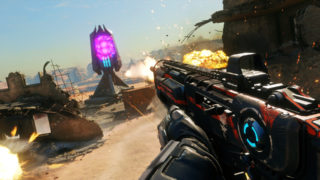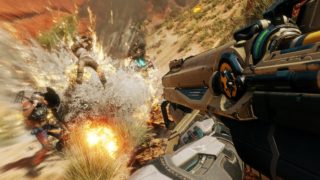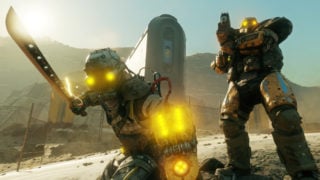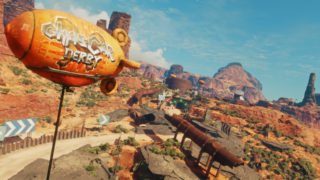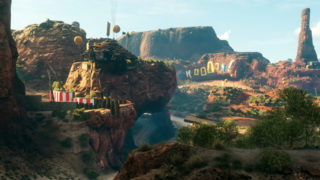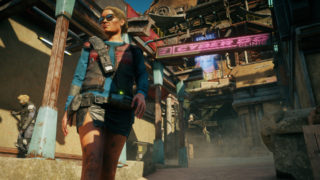Review: Rage 2 is another superb Id Shooter
id Software’s peerless shooter library gets another superb entry
- Game Director
- Magnus Nedfors
- Key Credits
- Jeremy Miller (Art Director), Fredrik Lönn (Technical Director)

A shooting game should be about shooting.
You can strap on all the added extras you want – make it open world, add RPG elements, vehicles, an ‘epic’ storyline – but ultimately, if it doesn’t feel great when the player pings an enemy from miles away, or reduce a room of baddies to a red paste, then it’s failed already. Thankfully, Rage 2 feels very good.
Although it’s an Avalanche game, there’s more than a hint of influence from co-developer id Software’s recent DOOM reboot. Slick and smooth movement, real freedom to take on legions of mutants in a way tailored to your play style and that almost unexplainable great feeling of impact and crunch to all of the guns, bullets, missiles and lasers you pick up on your travels.

The key antagonist in Rage 2 is The Authority, an army of post-human cyborgs who destroy the player’s settlement during the intro sequence and want to rid the world of the remaining humans. Players pick from a male or female ‘Walker’ and get inside a Ranger’s suit, salvaged from the body of its previous owner and is what allows them to use the combat powers you’ll find throughout the game.
The main feature is the Overdrive, which ramps up your damage output, gives you a temporary health regen and, later on, allows you to use some creative power ups and abilities to cause all kinds of chaos. Not that you’d know that from this pretty dry opening. In fact, Rage 2 really doesn’t put its best foot forward.
Players are thrust into a large – and largely empty – open world. The main objective is to traverse the land, eventually meeting these three clan leaders and bringing them together to take on The Authority. Sure, it’s supposed to be a post-apocalyptic wasteland, but there isn’t that much to do and barely anything to look at. You drive between settlements, picking up missions that are, for the most part “go here, kill all the enemies, report back”.
The variety, early game, basically boils down to whether you’re fighting the enemies in a warehouse, a sewer or a shanty town, or some other post-apocalyptic trope. For the first few hours, the signs are a bit worrying.
As you explore the wasteland, you will stumble across Vaults, which contain new weapons or abilities. Kill all of the enemies guarding them, grab the reward and complete a short tutorial so you’ve got an idea of what you’ve just picked up and get back out there with your new found toy.
These abilities are what makes Rage 2’s combat really start to shine, and it’s worth taking a bit of time to go out of your way to grab as many as you can as early as you can, before you really get into the meat of the game. They’re key to the variety and excitement that the firefights in Rage 2 can deliver and it’s a bit of a misstep that you don’t start with a lot of this stuff.
The weapons are characteristically fantastic, too. Rocket Launchers that can fire single missiles or a swarm of homing shots, a meaty, satisfying shotgun that can also be focused and used as a longer range blast and the Firestorm Revolver, that fires bullets that can be ignited with a literal click of the fingers. It’s just a shame that you simply won’t get your hands on a lot of these unless you go out of your way to seek them out.
“Rage 2 may start you out as a simple FPS soldier, but after a bit of time spent grabbing these abilities and levelling them up, a truly varied combat system opens up and, brilliantly, elevates a lot of other aspects of the game too.”
The more of these tools you have, the better Rage 2 gets. Some abilities add improved mobility, like a double jump and better sprint. A particular favourite is the Upgraded Slide – when in Overdrive mode players can chip enemies up into the air when they slide into them, allowing you to pop them with headshots while they sail through the air like clay pigeons.
These aren’t even the true offensive-based abilities, either. Shatter is a Jedi-esque ‘force push’ that sends enemies flying and strips them of their armour. There’s a huge ground slam that sends a shockwave through everything unfortunate to be around you when you land. Vortex pulls enemies into a plasma ball that erupts and kills everything around it. They’re fantastic fun to use, but what makes them special is the way you can tweak them to your specific play style.
Enemies drop Feltrite when they die, and you can use this to unlock additional levels for each ability – increasing things like the duration they last and damage they do – but inside each level there’s a skill tree that actually tweaks the actual effect of these abilities. For instance, there’s a barrier you can deploy that you can hide behind in firefights, but you can choose to have this barrier recharge your health whilst you’re using it for cover, or have it instantly kill anything that touches it. Every weapon has this progression system, too. Do you want increased fire rate or bullets that break an enemy’s armour?
At the end of these skill trees lie some really silly upgrades, such as bullets which return to the active clip for every kill, or melee attack power the increases the more point blank shots you fire. It encourages experimentation and rewards you for trying out combinations of abilities and weapons with gratuitous kills. See that barrier that kills enemies mentioned above? How about deploying that, then using Vortex to pull enemies straight through it?
“The variety of enemies grows, including some gigantic boss encounters that will test your skills, and the firefights – at their best – are right up there with some of the best in the genre.”
Rage 2 may start you out as a simple FPS soldier, but after a bit of time spent grabbing these abilities and levelling them up, a truly varied combat system opens up and, brilliantly, elevates a lot of other aspects of the game too.
Suddenly, the fact that the missions are largely just excuses to have you kill a bunch of enemies becomes less of an issue. The variety of enemies grows, including some gigantic boss encounters that will test your skills, and the firefights – at their best – are right up there with some of the best in the genre. Clever use of the abilities rewards you with some near cinematic moments, heroically overcoming some ridiculous odds and leaving you feeling incredibly satisfied.
The only area that doesn’t really improve is the vehicle gameplay. As mentioned, the open world is really quite barebones, although it certainly becomes a lot more attractive as you leave behind the desert wasteland and discover more lush jungle areas. Driving between some mission points can feel like a bit of a chore and quick travel points are quite few and far between.
Avalanche was behind the Mad Max game from a few years back – a game that really showed how vehicle combat should be done – so there’s definitely a marked improvement over the original Rage here. There’s some excellent Fury Road-esque convoy battles, which play out a lot like a classic ‘Shmup’ boss fight, where you have to destroy the minion vehicles before picking off guns and weak spots on the main convoy leader truck. Outside of those, however, there’s just not a lot to do.

A race here, a skirmish there, but unfortunately the vehicular combat doesn’t quite get the same treatment the on-foot stuff receives. As soon as you find the flying vehicles you’ll likely leave the road behind for the convenience of the skies. There is the promise of some post-launch ‘live’ events out in the world, which state that they include huge monsters to tackle, community events and things that actually alter the game world. There’s no doubt that these could spice things up a bit, but unfortunately these weren’t available by the time this review was completed.
The plot isn’t much to write home about, but it doesn’t really matter. You’re tasked with finding three leaders of wasteland clans and bringing them together to take on the Authority army. You can find them in any order, and after completing an initial quest you have to ‘level them up’ by completing sub quest. Once they hit level five (which doesn’t take long) you can take on a final story quest for them.
“It’s amazing how little Rage 2’s issues matter, because of how enjoyable the combat is. The slow start and uninspiring open world may damage the pace, but it’s a game that truly excels when you’re treading the line between being hopelessly outgunned and a super-powered Rambo.”
Crack them all and you can access the final story mission. All it really serves as an excuse for you to head out into the wasteland and blast some goons. If you power your way through it, you can finish it in around six hours and then you’re on to wrapping up the side missions, of which there are are considerable amount.
What salvages it is the characters you encounter. From returning characters from the original game, the Hulk Hogan meets Guy Fieri Klegg Clayton and the blood drinking host of Mutant Bash TV, Desdemonya Cold, there’s a lot of weird and wonderful people living in the wastes.
It’s amazing how little Rage 2’s issues matter, because of how enjoyable the combat is. The slow start and uninspiring open world may damage the pace, but it’s a game that truly excels when you’re treading the line between being hopelessly outgunned and a super-powered Rambo.
Once you’ve shaped your Walker with a few abilities that suit the way you want to approach the combat, you can find yourself in that sweet spot in almost every encounter. It’s a sweet spot shared by DOOM, by Quake, by every classic shooter that puts you in a sticky situation and forces you to think creatively to get yourself out of it. Not through talking your way out, or by sneaking in the shadows, but through some fine shooting action.
Bringing Avalanche on board seems like it has been a masterstroke, as id Software’s peerless shooter library gets another superb entry.
- Abilities, weapons and controls combine to create some of the best shooting in the genre.
- Excellent variety in how you can upgrade Walker.
- Guns and the abilities allows for expression of your play style.
- The largely empty open world feels like a bit of waste.
- A lot of wandering around before the fun starts.
